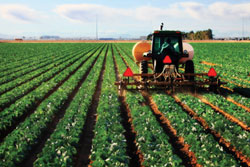Jan/Feb 2012
Standing Out
Agricultural engineering became a victim of its own success. Now this engineering discipline is searching for a new identity.
BY DANIELLE BOYKIN
 |
| Since 1926, the American Society of Agricultural and Biological Engineers has named 57 historic developments in agricultural engineering as landmarks. The triangular slow-moving vehicle emblem, developed by agricultural engineer Kenneth Harkness in the early 1960s, was named a landmark in 1992. Visit www.asabe.org to see the complete list. |
The mechanization of agriculture is recognized as one of the greatest engineering achievements of the 20th century. Agricultural engineers solved most of the major problems in their industry. They made a significant contribution to transforming society, but essentially became a victim of their success, as the demand for their specialized expertise dwindled and young people with technological interests veered away from the agriculture industry. As this century presents more challenges to solve, agricultural and biological engineers are determined to reemerge as major players in the profession.
Professional engineers with agricultural and biological engineering expertise are like other engineers who are the best at what they do, says Sonia Maassel Jacobsen, P.E., but they don't brag about it. "We suffer from limited name recognition. Human resources professionals often advertise for civil, mechanical, and environmental engineers in our industry," says Jacobsen, president of the American Society of Agricultural and Biological Engineers. "In many instances, agricultural and biological engineers are the most qualified for these positions. We definitely have an identity crisis."
Jacobsen and other engineers involved with the ASABE are focused on bringing more visibility to this segment of the profession. Publicizing how agricultural and biological engineers are once again advancing society through their work in areas such as biofuels; food processing; agricultural equipment development; and waste, water, and natural resources management is a top priority.
The Underdog
NSPE member Larry Hoover, P.E., considers agricultural engineers the "underdog" of the profession. "When you ask someone to name a few of the engineering disciplines, you get the mechanical, civil, nuclear, and electrical. These disciplines are in the forefront of everyone's thoughts," says Hoover, who serves on the ASABE board of trustees. "I think the tide is turning in a lot of areas, and people are going to start recognizing who we are and what we do. We are more than just farmers in engineering."
Hoover grew up on a Pennsylvania dairy farm, and he developed an interest in science and math in high school. The experience of participating in the Governor's School for Agricultural Science at Pennsylvania State University and working on a project in the university's agricultural engineering department opened his eyes. "Many students just stumble upon this engineering major. From day one, I knew it was a perfect fit between my love of agriculture and my interest in engineering," says Hoover, who has bachelor's and master's degrees in agricultural engineering and agricultural and biological engineering respectively.
During his 14-year career, Hoover has risen up the ranks at Case New Holland, a global supplier of agricultural and construction equipment. He started out in the product evaluation field and traveled throughout North America to test machinery as the precursor to upgrading model lines. He now manages new product development activity.
Hoover realizes that future agricultural and biological engineers will not have his farming background. He believes that expansion of the biological component of the engineering programs will be essential to growing the profession. "You have fewer and fewer people who are in touch with farming, and the term agriculture, in some circles, may not be in vogue," he acknowledges. "The biological aspect strikes a chord with a lot of young people. The ability of our society, universities, and departments to tap into that vein has led to that increase in interest. It will continue to do so in my opinion."
Agricultural and biological engineering programs in the U.S. do not have the large student enrollments when compared to civil or mechanical engineering programs. However, the programs have maintained steady growth over the last decade. In 2001, full-time student enrollment was 2,503 students and grew to 3,911 students in 2010, according to the American Society for Engineering Education. The programs awarded 549 bachelor's degrees in 2001, increasing to 719 degrees in 2010. "Most of the growth is in the biological systems engineering in the United States," says Jacobsen. "In other countries, the agricultural engineering is growing very large and very quickly because of the desire of other countries to catch up with America's agricultural expertise."
Jacobsen experienced this desire for American engineering expertise when she ventured to China last year to meet with an agricultural engineering society. "They wanted to pick my brain about all things related to agricultural engineering in the United States," she recalls. "They are trying to leapfrog ahead with some of the technology. They have many people to feed and a limited amount of land. It's about getting the most out of the land, and that includes improving production, both quality and quantity."
A New Generation
Daniel Thomas, P.E., recalls when the popularity of agricultural engineering declined in the 1980s. A part of that decline was due to the success of agricultural engineers. "We solved a lot of the major problems out there, and soon the industry didn't need so many of us anymore," says Thomas, a professor and head of Oklahoma State University's Biosystems and Agricultural Engineering department.
In order to survive, agricultural engineering programs evolved to include biological and biosystems engineering in the curriculum. Thomas also ties the resurgence to a new generation of young people that don't want to be the same type of engineer as their parents or grandparents' generation. "They want to make a difference and have an impact on society," he explains. "There are probably some students that don't want to make a fortune as an engineer either. Our program caters to that mentality."
Thomas believes that engineers with biological and agricultural engineering training are considered a "best-kept secret," but for him that's the worst-case scenario. "You don't want to be a secret—you want visibility," he says. "We are trying to create a national identity." This national identity will emerge as program graduates become more involved in developing new technologies, particularly in the bioenergy arena, adds Thomas.
Nearly 20 years ago, enrollment in the University of Kentucky's agricultural engineering program was at an all-time low with about 10 students. Similar to other programs in the nation, the school refocused and became the biosystems and agricultural engineering program. Two years ago, the freshman class had 60 students, and this year's class has 55. Department Chair Sue Nokes, P.E., believes that interest in biological systems and renewable energy has fueled the program's growth. "This change has allowed students to look at the degree a little differently and a bit more objectively. If you remove the word agriculture, they don't have the stereotypical prejudices," she says.
Nokes understands from personal experience why more young people, particularly women, are being drawn to these programs. She began her undergraduate college career as a nursing major when she entered Ohio State University. Her interest waned when she discovered the major lacked the number of math courses that she desired. She made the switch. "I liked the idea that I could focus on more math and science and do something biological at the same time," she recalls about choosing to major in agricultural engineering.
The employment prospects for young engineers are improving as industry employers seek a new breed of engineer. "These kids think differently because a lot of them don't come from the farm anymore. Employers are finding that's probably a valuable attribute," says Thomas. "They want somebody with some creative capability, good communication skills, and a solid foundation in biology, which factors in whether you're working with plants, animals, or the environment. These are valuable components for where things are going in the future."
Hoover believes it's a good time to be in the industry because qualified candidates are hard to find. "Agriculture is booming. Commodity prices are very good, and the agricultural businesses are refreshing equipment models," he says. "There will be a lot of room for good, young engineers to come in and establish themselves."
Hoover believes students with agricultural and biological engineering degrees have the necessary knowledge and interdisciplinary skills to succeed in the work world. "They come out more well-rounded because they have exposure to different systems and perspectives than some of the more traditional and narrower focused engineering disciplines," he says. "They are much more adaptable to a wider variety of jobs and are ready to meet the challenges that the workforce will throw them."
Although the public sector is facing workforce reductions, there will be a need for agricultural and biological engineers in government positions. "There is a group of engineers who are eligible to retire that are likely to go at any minute. The government won't replace everyone because that will be a part of the trimming process, but there will be a need for more engineers," says Jacobsen, who is employed with a federal agency.
Professional Integrity
Licensure is not required of engineers employed in the agricultural industry, but professional engineers leading university programs and in industry are promoting it as a career essential. Jacobsen recalls her academic advisor telling her and her classmates quite simply, "You will all get licensed." That was when she realized that licensure was necessary to professional integrity. "I prefer people who work with me to be licensed engineers because I oversee contract work. It would be [hypocritical] if I required licensure of contractors, but I didn't have a license," says Jacobsen, who served on Minnesota's engineering licensing board for eight years.
ASABE offers an incentive program to encourage members to become licensed. First-time test takers receive reimbursements, and the society is planning to provide an additional incentive for new test takers this year. The society also offers free online seminars and an online study guide.
Nokes teaches the freshman engineering course, and right from the start, she informs students about the importance of an engineering license and the path to becoming a PE. A high percentage of the students take the FE exam by graduation. "We were always taught that that's just what you do," she recalls. That turned out to be a good advice for Nokes because Kentucky law requires engineering professors to be licensed if they teach a senior design course.
Thomas' department recently decided to require that students take the FE exam prior to graduation. "We think the FE is a starting point to make sure that they have the fundamentals," he says. "We understand the value of being licensed, obtaining continuing education, and being absolutely sure of the quality of designs, particularly when it relates to product liability issues."
Although not required by industry to do so, Hoover took the agricultural engineering exam and became licensed in 2007. He is a firm believer that if you're going to be an engineer, you should have the credentials to back it up. "It was a personal goal, and I knew that if I was going to be an engineer, I wanted to be a professional engineer. It lends credibility."


 Volunteering at NSPE is a great opportunity to grow your professional network and connect with other leaders in the field.
Volunteering at NSPE is a great opportunity to grow your professional network and connect with other leaders in the field. The National Society of Professional Engineers (NSPE) encourages you to explore the resources to cast your vote on election day:
The National Society of Professional Engineers (NSPE) encourages you to explore the resources to cast your vote on election day: